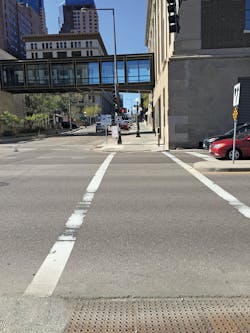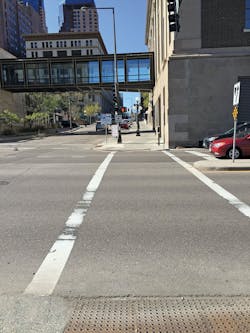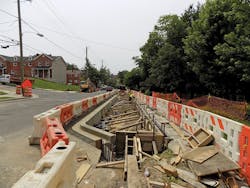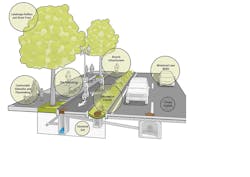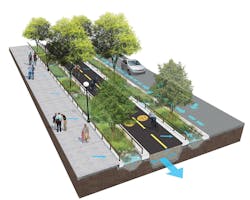Green Complete Streets: Integrating the puzzle pieces
Roads, as traditionally built, are incomplete.
They are typically designed and built with one mode in mind: the automobile. Elements of the street, such as the travelway, roadside and utilities, are designed individually without communication or coherence. Complete streets are the logical opposite. They prioritize users based on vulnerability and ensure the entire right-of-way is designed as one entity.
However, a truly complete street should account for more than just safe movement for all users, as the right-of-way also contains elements such as storm water and street vegetation. A flooded street, after all, is not complete, and it takes solutions such as green infrastructure to properly manage the street landscape. This approach is known as green streets.
Incorporating both needs is achievable in green complete streets, where complete-street design incorporates components of green streets. The key challenge in implementing green complete streets is designing for all the competing demands on the public right-of-way.
The Capital City Bikeway Network in St. Paul, Minn., prioritizes green infrastructure and sense of place in the heart of downtown by focusing on sidewalks and buffers as well as the roadway.
Complete and green go hand-in-hand
Calling them “streets for everyone,” the National Complete Streets Coalition defines a complete street as one that enables everyone on the road to travel safely and comfortably, regardless of their mode of travel, age and needs. The aim is to make a community more walkable and bikeable, while maintaining both the flow of traffic and the precision and reliability of transit by creating a complete system. Some complete street elements are protected bike lanes, narrower travel lanes, wider sidewalks and street vegetation.
Green streets incorporate green storm-water management strategies and facilities that use vegetation, soils, permeable surfaces and engineering principles to collect, infiltrate, convey and clean storm-water runoff from the streets. Some green street elements are bioretention curb extensions and planters.
Though they may seem to focus on different goals, complete streets and green streets complement each other extremely well. By preventing storm-water flooding, and increasing vegetation and tree canopy on the street, green streets play a role in providing the safety and comfort for users that complete streets aim for. A key element in achieving successful green complete streets is to focus on multifunctional uses for all elements. Best practices include using porous asphalt on travel and bike lanes, and permeable pavers on parking lanes; creating bioretention swales within buffers and amenity zones; replacing regular planter soils with structural soils and Silva cells, which are a modular-suspended pavement system that uses soil volumes to support large tree growth and provide powerful on-site storm-water management through absorption, evapotranspiration, and interception to allow storm-water infiltration and additional soil volumes to support tree growth; and integrating tree canopy to create welcoming public spaces. A typical green complete street cross-section varies from one location to the other depending on local needs and existing conditions.
Toole Design Group is leading the design of green infrastructure facilities on Dix Street as part of the District of Columbia’s citywide effort to increase green infrastructure and low-impact development.
How are green complete streets implemented?
Despite competing demands, implementing green infrastructure in urban streets encourages designers to integrate uses and agencies to partner to achieve their respective goals. Inter-departmental collaboration from day one allows the different city departments to have a broader perspective that considers all aspects of operational and maintenance needs.
During the collaboration process, transportation agencies become aware of storm-water management utility needs as well as its benefits for roadway projects. Continuing collaboration through the last stages of a project allows cities to unlock opportunities for new funding and operations and maintenance partnerships. For example, agencies can use a Transportation Alternatives Program fund to implement green infrastructure when it is part of a complete street project.
The remainder of this article profiles the goals, design details and key lessons learned from two successful green complete street projects: The Capital City Bikeway Network in St. Paul, Minn., and Dix Street in Washington, D.C.
Green streets incorporate green storm-water management strategies and facilities that use vegetation, soils, permeable surfaces and engineering principles to collect, infiltrate, convey and clean storm-water runoff from the streets.
The Capital City Bikeway
St. Paul, Minn., recently led one of its most important public improvements in recent history. The St. Paul Bicycle Plan identifies a network of bicycle facilities to be developed in the core of the city’s downtown as a top priority for encouraging bicycle ridership and economic development. The Capital City Bikeway Network Study and Design Guide and the transformative streetscape design for the Jackson Street reconstruction set the standard for implementing innovative green complete streets.
This project creates a memorable, inviting urban streetscape in the heart of downtown. In addition, it prioritizes green infrastructure and sense of place along corridors by approaching street design from building faces inward, focusing on sidewalks and buffers as well as the roadway. The design includes widened walkways, a signature protected bikeway facility, green infrastructure elements, landscaped buffers, public art and sitting areas.
The city of St. Paul approved a Complete Streets Resolution in 2009. The resolution inspired the bicycle plan and the Bikeway Network, directing city staff to follow a complete streets approach in roadway development projects. The Capital City Bikeway Network Study and Design Guide provides guidance on design and implementation of interim bikeway treatments, as well as initial design concepts for project phases as funding becomes available.
The Capital City Bikeway is a protected bikeway network that also connects to regional and state trail systems located on the edge of the downtown area. The bikeway is a 10-ft two-way path separated from traffic and sidewalk by green buffers that vary in width between 4 ft and 11 ft.
The project features significant green infrastructure elements that improve water quality and reduce storm-water runoff along the corridor. Porous asphalt pavement for the bike path, along with green storm-water best management practices in the form of bio-infiltration basin systems, allow runoff infiltration and filter pollutants through plants and amended soils. The anticipated filtration volume along the street is 40,724 cu ft annually, while the pollutant removal rate is 775 lb of total suspended solids and 2.34 lb of particulate phosphorus annually.
As part of this network, Jackson Street is designed to cater to all users, focusing on those between the ages of 8 and 80. It accommodates pedestrians and bicyclists with wider sidewalks and a two-way separated bike lane, while keeping in mind both motor-vehicle traffic and parking and loading zones. In addition to ADA-compliant ramps, the bikeway is designed to ramp down 10 ft minimum before pedestrian crosswalks to ensure accessibility for users.
A variety of ornamental and canopy trees are planted along the bikeway. Canopy trees are picked to have a minimum height of 40 ft and provide a significant canopy over the bikeway. The purpose of ornamental trees is to add color and fragrance to the path. Moreover, art and light installations are included at gateways, landmarks and underpasses along the path to add to the rider’s experience and highlight Jackson Street as a destination. Also, Capital City Bikeway branding connects Jackson Street facilities to the citywide network that will be built in the future.
The project followed a charrette-based approach for developing design alternatives, including extensive public and stakeholder engagement. Conceptual graphics were thoughtfully prepared to accurately represent the constructed conditions so that expectations were met at project completion. Coordination throughout the project included collaboration with policy, technical and community advisory committees consisting of key city staff and/or community stakeholders.
Jackson Street is the first downtown project funded by the city’s 8-80 Vitality Fund. This fund promotes livable cities where people of all ages, backgrounds, and abilities are safe, invigorated, and welcomed by their community. Jackson Street’s design, by integrating different street infrastructure elements to create vibrant and safe spaces for everyone, was able to use this fund for green infrastructure and transportation improvements.
Dix Street will feature 2,274 sq ft of permeable pavers at parking areas, and 4,717 sq ft of curb extensions with bioretention planting areas.
D.C.’s Dix Street
As part of the District of Columbia Department of Transportation’s (DDOT) citywide effort to increase green infrastructure and low-impact development (LID), Toole Design Group is leading the design of green infrastructure facilities on Dix Street. The team performed site evaluation for storm-water drainage patterns, parking and building entrance locations to determine the best possible sites for the installation of bioretention curb extensions. The team created concepts and developed construction documents for Dix Street, which included pedestrian improvements and green infrastructure. These features will not only address the general condition of the street, but they also will help increase green space in the neighborhood.
DDOT adopted the Sustainable D.C. plan in 2013 and released the Green Infrastructure standards in 2014. Both guided the LID Action Plan that includes Dix Street. Once the project is fully implemented, Dix Street will feature 2,274 sq ft of permeable pavers at parking areas, and 4,717 sq ft of curb extensions with bioretention planting areas. Trees will be planted along the sides of the street and at a park entrance to increase the canopy cover. The street also will feature raised intersections to help slow traffic; shorter pedestrian crossing distances; ADA-compliant ramps and crossings; new sidewalks; and a new entrance into a neighborhood park.
One of the key elements to this project has been getting the community and neighborhood involved. The team performed community outreach meetings on the street itself to gather as many residents as possible to get direct feedback and support and explain visually what the project involved by walking the street.
This project falls under the DDOT LID retrofit program and is in fulfillment of the EPA Municipal Separate Storm Sewer System (MS4) permit, which requires owners and operators to implement a collective series of programs to reduce the discharge of pollutants from the given storm sewer system to the maximum extent practicable in a manner that protects the water quality of nearby streams, rivers, wetlands and bays. Collaboration between DDOT and District Department of Environment (DDOE) has been key throughout the project. DDOE guided the storm-water requirements and provided additional funding resources to the Stormwater Permit Compliance Enterprise Fund.
The Capital City Bikeway Network Study and Design Guide for St. Paul, Minn., and the transformative streetscape design for the Jackson Street reconstruction set the standard for implementing innovative green complete streets.
Lessons learned
Now that these projects are fully underway and being employed, team members have been able to collect and synthesize a series of learned lessons to aid future green complete streets initiatives. Among them are:
- Understand existing constraints: Existing utility locations, depths and required setbacks are critical information for green infrastructure, and may vary by service provider;
- Support adjacent land use: Rethinking the street from the building frontage inward results in wider, greener and more comfortable buffers for pedestrians and bicyclists;
- Buffers can be multifunctional: Landscaping between all modes of travel creates aesthetically pleasing, vertical elements to orient people with vision impairments;
- Maintain access: Keeping accessible cut-throughs in the landscaping is critical for getting people with mobility needs to the sidewalk;
- Intersections are important: Intersections are where most crashes occur. It is critical to include designs that slow traffic and improve sightlines, such as Dutch-style “protected” intersections and enhanced pedestrian treatments;
- Engagement is critical: Sometimes you need to go to the community to get the best participation. Organizing public meetings in the neighborhoods, on the streets themselves, received much better turnout than the typical community meetings at a civic building off-site; and
- Early coordination is paramount: Bring various city departments and services along in the planning and design process. Include fire, public and franchise utilities, operations and maintenance in addition to transportation and storm water.
The author wishes to acknowledge Amalia Leighton, Alia Anderson and Cindy Zerger for their assistance with this article.
